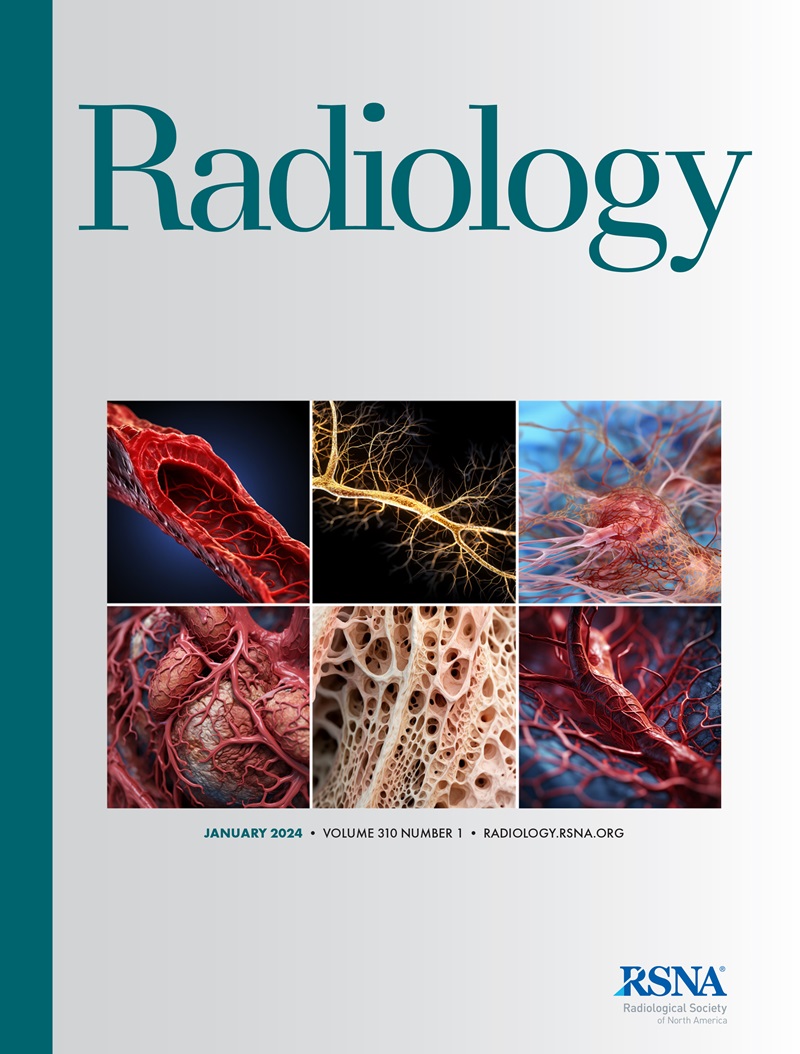Right Ventricular Strain Improves Cardiac MRI-based Prognostication in Heart Failure with Preserved Ejection Fraction.
IF 12.1
1区 医学
Q1 RADIOLOGY, NUCLEAR MEDICINE & MEDICAL IMAGING
Leyi Zhu, Huaying Zhang, Mengdi Jiang, Jing Xu, Di Zhou, Weichun Wu, Wenjing Yang, Yining Wang, Gang Yin, Arlene Sirajuddin, Andrew E Arai, Qiang Zhang, Shihua Zhao, Minjie Lu
下载PDF
{"title":"Right Ventricular Strain Improves Cardiac MRI-based Prognostication in Heart Failure with Preserved Ejection Fraction.","authors":"Leyi Zhu, Huaying Zhang, Mengdi Jiang, Jing Xu, Di Zhou, Weichun Wu, Wenjing Yang, Yining Wang, Gang Yin, Arlene Sirajuddin, Andrew E Arai, Qiang Zhang, Shihua Zhao, Minjie Lu","doi":"10.1148/radiol.243080","DOIUrl":null,"url":null,"abstract":"<p><p>Background Right ventricular (RV) function is an independent predictor of clinical status and prognosis in multiple cardiovascular diseases; however, the prognostic value of RV strain in patients with heart failure with preserved ejection fraction (HFpEF) remains largely unknown. Purpose To determine the associations between RV strain variables derived from cardiac MRI feature tracking and adverse outcomes in patients with HFpEF. Materials and Methods This retrospective study included patients with HFpEF who underwent cardiac MRI from January 2010 to December 2018. The primary end point was all-cause mortality. The results were validated in a cohort of patients with HFpEF enrolled from January 2019 to June 2021. Cox regression analysis was performed to assess the associations between variables and clinical outcomes. Results The development cohort comprised 1019 patients (mean age, 56.9 years ± 12.3 [SD]; 710 men), and the validation cohort comprised 273 patients (mean age, 55.3 years ± 14.0; 191 men). During a median follow-up of 7.8 and 3.9 years, respectively, 103 patients in the development cohort and nine in the validation cohort died. Multivariable Cox regression analysis showed that RV global longitudinal and circumferential strain were independent predictors of all-cause mortality (adjusted hazard ratio per 1% increase, 1.07 [95% CI: 1.02, 1.12; <i>P</i> = .005] and 1.13 [95% CI: 1.05, 1.21; <i>P</i> < .001], respectively). The full model based on clinical, conventional imaging, and RV strain variables demonstrated the best discrimination performance in the development (C index = 0.794) and validation (C index = 0.782) cohorts. In a subgroup with T1 mapping data, RV global longitudinal and circumferential strain remained independent predictors after separate adjustment for native T1 value and extracellular volume fraction (all models, <i>P</i> < .05). Conclusion RV global longitudinal and circumferential strain derived from cardiac MRI were independent predictors of adverse outcomes in patients with HFpEF, providing greater prognostic value than traditional clinical and imaging-derived risk markers. © RSNA, 2025 <i>Supplemental material is available for this article.</i> See also the editorial by Murphy and Quinn in this issue.</p>","PeriodicalId":20896,"journal":{"name":"Radiology","volume":"315 3","pages":"e243080"},"PeriodicalIF":12.1000,"publicationDate":"2025-06-01","publicationTypes":"Journal Article","fieldsOfStudy":null,"isOpenAccess":false,"openAccessPdf":"https://www.ncbi.nlm.nih.gov/pmc/articles/PMC12207649/pdf/","citationCount":"0","resultStr":null,"platform":"Semanticscholar","paperid":null,"PeriodicalName":"Radiology","FirstCategoryId":"3","ListUrlMain":"https://doi.org/10.1148/radiol.243080","RegionNum":1,"RegionCategory":"医学","ArticlePicture":[],"TitleCN":null,"AbstractTextCN":null,"PMCID":null,"EPubDate":"","PubModel":"","JCR":"Q1","JCRName":"RADIOLOGY, NUCLEAR MEDICINE & MEDICAL IMAGING","Score":null,"Total":0}
引用次数: 0
引用
批量引用
Abstract
Background Right ventricular (RV) function is an independent predictor of clinical status and prognosis in multiple cardiovascular diseases; however, the prognostic value of RV strain in patients with heart failure with preserved ejection fraction (HFpEF) remains largely unknown. Purpose To determine the associations between RV strain variables derived from cardiac MRI feature tracking and adverse outcomes in patients with HFpEF. Materials and Methods This retrospective study included patients with HFpEF who underwent cardiac MRI from January 2010 to December 2018. The primary end point was all-cause mortality. The results were validated in a cohort of patients with HFpEF enrolled from January 2019 to June 2021. Cox regression analysis was performed to assess the associations between variables and clinical outcomes. Results The development cohort comprised 1019 patients (mean age, 56.9 years ± 12.3 [SD]; 710 men), and the validation cohort comprised 273 patients (mean age, 55.3 years ± 14.0; 191 men). During a median follow-up of 7.8 and 3.9 years, respectively, 103 patients in the development cohort and nine in the validation cohort died. Multivariable Cox regression analysis showed that RV global longitudinal and circumferential strain were independent predictors of all-cause mortality (adjusted hazard ratio per 1% increase, 1.07 [95% CI: 1.02, 1.12; P = .005] and 1.13 [95% CI: 1.05, 1.21; P < .001], respectively). The full model based on clinical, conventional imaging, and RV strain variables demonstrated the best discrimination performance in the development (C index = 0.794) and validation (C index = 0.782) cohorts. In a subgroup with T1 mapping data, RV global longitudinal and circumferential strain remained independent predictors after separate adjustment for native T1 value and extracellular volume fraction (all models, P < .05). Conclusion RV global longitudinal and circumferential strain derived from cardiac MRI were independent predictors of adverse outcomes in patients with HFpEF, providing greater prognostic value than traditional clinical and imaging-derived risk markers. © RSNA, 2025 Supplemental material is available for this article. See also the editorial by Murphy and Quinn in this issue.
右心室应变改善心脏mri对保留射血分数的心力衰竭患者的预后。
背景右心室(RV)功能是多种心血管疾病临床状态和预后的独立预测因子;然而,RV毒株在保留射血分数(HFpEF)的心力衰竭患者中的预后价值在很大程度上仍然未知。目的确定HFpEF患者心脏MRI特征跟踪得出的RV应变变量与不良结局之间的关系。材料与方法本回顾性研究纳入了2010年1月至2018年12月期间接受心脏MRI检查的HFpEF患者。主要终点为全因死亡率。研究结果在2019年1月至2021年6月登记的HFpEF患者队列中得到验证。采用Cox回归分析评估变量与临床结果之间的关系。结果发展队列包括1019例患者(平均年龄56.9岁±12.3岁[SD];710名男性),验证队列包括273名患者(平均年龄55.3岁±14.0岁;191人)。在中位随访7.8年和3.9年期间,开发组103例患者和验证组9例患者死亡。多变量Cox回归分析显示,RV全球纵向和周向应变是全因死亡率的独立预测因子(校正风险比每增加1%,1.07 [95% CI: 1.02, 1.12;P = 0.005]和1.13 [95% CI: 1.05, 1.21;P < 0.001])。基于临床、常规影像学和RV菌株变量的全模型在发育队列(C指数= 0.794)和验证队列(C指数= 0.782)中表现出最佳的识别性能。在具有T1映射数据的亚组中,单独调整原生T1值和细胞外体积分数后,RV整体纵向和周向应变仍然是独立的预测因子(所有模型,P < 0.05)。结论心脏MRI得出的右心室整体纵向和周向应变是HFpEF患者不良结局的独立预测指标,比传统的临床和影像学风险指标具有更大的预后价值。©RSNA, 2025本文可获得补充材料。参见墨菲和奎因在本期的社论。
本文章由计算机程序翻译,如有差异,请以英文原文为准。

 求助内容:
求助内容: 应助结果提醒方式:
应助结果提醒方式:


